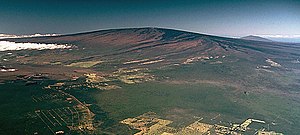മൗണ ലോവ
| മൗണ ലോവ / Mauna Loa | |
|---|---|
 Mauna Loa as seen from the air. Hualālai is visible in the background. | |
| ഉയരം കൂടിയ പർവതം | |
| Elevation | 13,679 ft (4,169 m) [1] |
| Prominence | 7,079 ft (2,158 m) [1] |
| Listing |
|
| Coordinates | 19°28′46″N 155°36′10″W / 19.47944°N 155.60278°W |
| ഭൂമിശാസ്ത്രപരമായ പ്രത്യേകതകൾ | |
Hawaii, U.S. | |
| Parent range | Hawaiian Islands |
| Topo map | USGS Mauna Loa |
| ഭൂവിജ്ഞാനീയം | |
| Age of rock | 700,000–1 million[2] |
| Mountain type | Shield volcano |
| Volcanic arc/belt | Hawaiian-Emperor seamount chain |
| Last eruption | March–April 1984[2] |
| Climbing | |
| First ascent | Ancient times |
| Easiest route | Ainapo Trail |
പസഫിക് സമുദ്രത്തിൽ സ്ഥിതി ചെയ്യുന്ന അമേരിക്കൻ സംസ്ഥാനമായ ഹവായിയിലെ അഞ്ച് അഗ്നി പർവ്വതങ്ങളിൽ ഒന്നാണ് മൗണ ലോവ (Mauna Loa /ˌmɔːnə ˈloʊ.ə/ or /ˌmaʊnə ˈloʊ.ə/; Hawaiian: ഫലകം:IPA-haw; ഇംഗ്ലീഷ്: Long Mountain[3]). പിണ്ഡത്തിലും അളവിലും ഏറ്റവും വലിയ ഭൗമോപരിതല അഗ്നിപർവ്വതമായ ഇതിനെ താമു മാസിഫ് കഴിഞ്ഞാൽ ഭൂമിയിലെ ഏറ്റവും വലിയ അഗ്നിപർവ്വതമായി കണക്കാക്കപ്പെടുന്നു.[4] താരതമ്യേന കുറഞ്ഞ ചരിവുകളോട് കൂടിയ ഒരു സജീവ ഷീൽഡ് അഗ്നിപർവ്വതമായ ഇതിന്റെ വ്യാപ്തം ഏകദേശം 18,000 cubic miles (75,000 km3) ആകുന്നു,[5] എന്നിരുന്നാലും ഇതിന്റെ ഉയരം തൊട്ടടുത്തായി സ്ഥിതിചെയ്യുന്ന മൗണ കിയയെക്കാൾ 125 feet (38 m) കുറവാണ്.[6]
മൗണ ലോവ, ഏഴ് ലക്ഷം വർഷമെങ്കിലും മുമ്പേ പൊട്ടിത്തെറിച്ചിരിക്കാമെന്നും, ഏകദേശം നാൽ ലക്ഷം വർഷങ്ങൾക്ക് മുമ്പ് സമുദ്രനിരപ്പിൽ നിന്ന് ഉയർന്നുവന്നിരിക്കാമെന്നും കരുതപ്പെടുന്നു. കാലനിർണ്ണയം ചെയ്യപ്പെട്ട ഏറ്റവും പഴക്കം ചെന്ന പാറകൾ 200,000 വർഷത്തിൽ കൂടുതൽ പഴക്കമുള്ളതല്ല.[7] കോടിക്കണക്കിന് വർഷങ്ങളായി ഹവായിയൻ ദ്വീപ് ശൃംഖല സൃഷ്ടിച്ചതിന്റെ കാരണമായ ഹവായ് ഹോട്ട്സ്പോട്ടിൽ നിന്നാണ് അഗ്നിപർവ്വതത്തിന്റെ മാഗ്മ വരുന്നത്. പസഫിക് പ്ലേറ്റിന്റെ മന്ദഗതിയിലുള്ള ചലനം കാരണം ക്രമേണ മൗണ ലോവയെ അഞ്ച് ലക്ഷം മുതൽ ഒരു ദശലക്ഷം വർഷങ്ങൾക്കുള്ളിൽ ഹോട്ട്സ്പോട്ടിൽ നിന്ന് അകറ്റിക്കളയും, ആ സമയത്ത് ഈ അഗ്നിപർവ്വതം ലുപ്തമോയേക്കാം(extinct).
മൗണ ലോവയുടെ ഏറ്റവും അടുത്ത കാലത്ത് നടന്ന അഗ്നിപർവ്വതസ്ഫോടനം 1984 മാർച്ച് 24 മുതൽ ഏപ്രിൽ 15 വരെ ആയിരുന്നു. അഗ്നിപർവ്വതത്തിന്റെ സമീപകാല സ്ഫോടനങ്ങളൊന്നും മരണത്തിന് കാരണമായില്ല, പക്ഷേ 1926 ലും 1950 ലും ഉണ്ടായ പൊട്ടിത്തെറികൾ ഗ്രാമങ്ങളെ നശിപ്പിച്ചു, 19-ആം നൂറ്റാണ്ടിന്റെ അവസാനത്തിൽ നിന്നുള്ള ലാവാ പ്രവാഹങ്ങളിലാണ് ഹിലോ നഗരം ഭാഗികമായി നിർമ്മിച്ചിരിക്കുന്നത്. ജനവാസകേന്ദ്രങ്ങൾക്ക് കാര്യമായ നാശനഷ്ടം വരുത്താൻ സാധ്യതയുള്ളതിനാൽ, ലോകത്തിലെ ഏറ്റവും അപകടകരമായ അഗ്നിപർവ്വതങ്ങളെക്കുറിച്ചുള്ള പഠനങ്ങളെ പ്രോത്സാഹിപ്പിക്കുന്ന ദശകത്തിലെ അഗ്നിപർവ്വതം (Decade Volcanoes)പരിപാടിയുടെ ഭാഗമാണ് മൗണ ലോവ. 1912 മുതൽ ഹവായിയൻ അഗ്നിപർവ്വത നിരീക്ഷണാലയം മൗണ ലോവയെ നിരീക്ഷിക്കുന്നുണ്ട്. അന്തരീക്ഷ നിരീക്ഷണങ്ങൾ മൗണ ലോവ ഒബ്സർവേറ്ററിയിലും സൂര്യ നിരീക്ഷണങ്ങൾ നിരീക്ഷണങ്ങൾ മൗണ ലോവ സോളാർ ഒബ്സർവേറ്ററിയിലും നടക്കുന്നു, മൗണ ലോവയുടെ കൊടുമുടിക്ക് സമീപം ആണ് ഈ ഒബ്സർവേറ്ററികൾ സ്ഥിതിചെയ്യുന്നത്. ഹവായ് അഗ്നിപർവ്വത ദേശീയ ഉദ്യാനത്തിൽ കൊടുമുടിയും അഗ്നിപർവ്വതത്തിന്റെ തെക്കുകിഴക്കൻ ഭാഗവും മറ്റൊരു അഗ്നിപർവ്വതമായ കൊളാവിയയും ഉൾക്കൊള്ളുന്നു.
ഭൂഗർഭശാസ്ത്രം
[തിരുത്തുക]ചരിത്രം
[തിരുത്തുക]യൂറോപ്യന്മാർ എത്തുന്നതിനുമുമ്പ്
[തിരുത്തുക]ആദിമ ഹവായിയൻ നിവാസികൾ ഭക്ഷണവും ജലവും സുലഭമായിരുന്ന തീരപ്രദേശങ്ങളിലായിരുന്നു ജീവിച്ചിരുന്നത്[8] ദ്വീപിലെ പറക്കാൻ കഴിയാതിരുന്ന പക്ഷികൾ അവർക്ക് നല്ല ഭക്ഷണസ്രോതസ്സായിരുന്നു.[9] ആദ്യകാല നിവാസികൾ പല ജീവജാലങ്ങളും പ്രതേകിച്ച് പക്ഷികളുടെ വംശനാശം സംഭവിക്കാൻ കാരണമാവുകയും പുതിയ ജീവികളേയും സസ്യങ്ങളേയും കൊണ്ടുവന്നത് മണ്ണൊലിപ്പ് കൂടാൻ കാരണമാവുകയും ചെയ്തു. [10] അവിടത്തെ താഴ്ന്ന പ്രദേശങ്ങളിലെ വന പരിസ്ഥിതി വ്യവസ്ഥ, കാട്ടിൽ നിന്ന് പുൽമേടായി രൂപാന്തരപ്പെട്ടു. പരിസ്ഥിതി നാശത്തിന്റെ പ്രധാന കാരണങ്ങൾ തീയും പോളിനേഷ്യൻ എലിയുടെ വരവുമായിരുന്നു (Rattus exulans).[11]
പുരാതന ഹവായിയൻ മതങ്ങൾ ദ്വീപിന്റെ അഞ്ച് അഗ്നിപർവ്വത കൊടുമുടികൾ, പ്രത്യേകിച്ചും ഏറ്റവും വലിയ മൗണ ലോവ, പവിത്രമാണെന്നു കരുതിയിരുന്നു [12]
അവലംബം
[തിരുത്തുക]- ↑ 1.0 1.1 "Mauna Loa, Hawaii". Peakbagger.com. Retrieved 12 December 2012.
- ↑ 2.0 2.1 ഉദ്ധരിച്ചതിൽ പിഴവ്: അസാധുവായ
<ref>ടാഗ്;hvo-loaഎന്ന പേരിലെ അവലംബങ്ങൾക്ക് എഴുത്തൊന്നും നൽകിയിട്ടില്ല. - ↑ "Mauna Loa: Earth's Largest Volcano". USGS. 2 February 2006. Archived from the original on 2015-08-09. Retrieved 21 October 2015.
- ↑ ഉദ്ധരിച്ചതിൽ പിഴവ്: അസാധുവായ
<ref>ടാഗ്;tamuഎന്ന പേരിലെ അവലംബങ്ങൾക്ക് എഴുത്തൊന്നും നൽകിയിട്ടില്ല. - ↑ Kaye, G.D. (2002). Using GIS to estimate the total volume of Mauna Loa Volcano, Hawaii. Geological Society of America. 98th Annual Meeting. Archived from the original on 2009-01-25. Retrieved 2020-01-03.
- ↑ "Mauna Kea". NGS Station Datasheet. United States National Geodetic Survey. Retrieved February 15, 2019.
- ↑ "Mauna Loa: Earth's Largest Volcano". United States Geological Survey. February 2, 2006. Archived from the original on 2015-08-09. Retrieved 2007-07-28.
- ↑ "Final Environmental Statement for the Outrigger Telescopes Project: Volume II" (PDF). NASA. February 2005. p. C–9. Archived from the original (PDF) on 21 April 2009. Retrieved 4 September 2012.
- ↑ "Culture: The First Arrivals: Native Hawaiian Uses" (PDF). Mauna Kea Mountain Reserve Master Plan. University of Hawaii. Archived from the original (PDF) on 8 November 2012. Retrieved 2 September 2012.
- ↑ Kirch, Patrick V. (January 1982). "The Impact of the Prehistoric Polynesians on the Hawaiian Ecosystem". Pacific Science. University of Hawai’i Press. 36 (1): 1–14. Retrieved 2 September 2012.
- ↑ Athens, Stephen; Tuggle, H. David; Ward, Jerome V.; Welch, David J. (2002). "Avifaunal Extinctions, Vegetation Change and Polynesian Impacts in Prehistoric Hawai'i". Archaeology in Oceania. 37 (2): 57. doi:10.1002/j.1834-4453.2002.tb00507.x. Archived from the original on 2012-06-05. Retrieved 4 September 2012.
- ↑ Caitlin Kelly. "Information on the Mauna Loa Volcano in Hawaii". USA Today. Archived from the original on 2012-10-06. Retrieved 27 January 2013.
Text is available under the CC BY-SA 4.0 license; additional terms may apply.
Images, videos and audio are available under their respective licenses.




